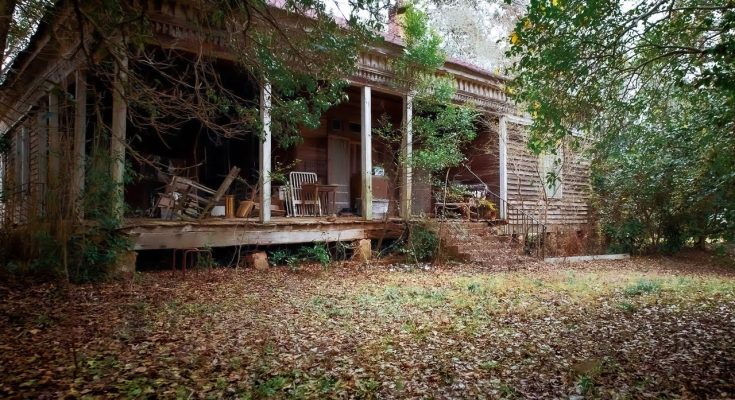An abandoned farmhouse from the 1800s, filled with artifacts left behind, evokes a sense of mystery and nostalgia. These forgotten homes, once vibrant with life, hold layers of history within their walls. Walking through such a farmhouse reveals remnants of its former inhabitants—old photographs, furniture, trinkets, and everyday items that tell the story of a bygone era.
The farmhouse, often set on overgrown land, might include weathered barns, rusted farm equipment, and faded tools left exactly as they were decades ago. Each room offers a window into the past: peeling wallpaper, crumbling plaster, and wood floors creaking underfoot. Objects like vintage sewing machines, old farm boots, or yellowed letters scattered on tables give a tangible connection to the people who once called it home.
### The Farmhouse’s Origins
Farmhouses from the 1800s were often the centerpieces of family-run farms, built sturdily to last through generations. Many were crafted by hand, using local materials and traditional construction methods. The foundation of these homes was usually made from stone or brick, while the frame was wood. Large, multi-paned windows allowed plenty of natural light to pour into the home. Fireplaces and wood-burning stoves were common for heating.
During this time, the farm itself was the lifeblood of the family. Crops were grown, livestock was raised, and everything from butter to bread was made by hand. The home was designed to serve both practical and social functions, with large kitchens, common rooms, and porches where family members could gather.
### Discovery of Forgotten Spaces
Exploring an abandoned 1800s farmhouse often begins with the exterior. Time has left its mark on the structure, with paint long since chipped away, leaving exposed wood and stone. Weeds and vines may have claimed much of the yard, and nature might have found its way into the home itself through broken windows and doors. Once inside, each room tells a story of the people who lived there and the passage of time.
The kitchen, often the heart of a farmhouse, might still have pots hanging from hooks, dishes on open shelves, and even a dusty wood stove. Old spice jars, tins, and dried herbs could still be found on counters or inside cabinets. In the living room, there might be a fireplace surrounded by wooden rocking chairs, an old piano, or a bookcase filled with crumbling volumes. These objects reflect a simpler way of life, where entertainment came from music, books, and conversation.
Upstairs, the bedrooms may hold iron-framed beds, faded quilts, and dressers with tarnished mirrors. The closets might contain vintage clothing, boots, or hats that have been untouched for decades. These rooms often feel the most intimate, filled with personal belongings that were never reclaimed.
### The Haunting Silence
One of the most eerie and fascinating aspects of exploring abandoned farmhouses is the silence. The absence of human activity gives these spaces a ghostly, surreal feeling. It’s as though time has paused inside, allowing visitors to step back into another world. The creaking floorboards, the wind whistling through broken windows, and the occasional sound of an animal scurrying nearby add to the atmosphere.
For many explorers, the question arises: why was this home abandoned? Often, economic hardship, changes in farming practices, or the migration of families to urban areas led to these homes being left behind. Over the years, without caretakers, the homes fell into disrepair, slowly being reclaimed by nature.
### Unearthing Hidden Treasures
Within these farmhouses, some items hold more than just nostalgic value. Antique furniture, original artwork, handmade quilts, or old tools can often be salvaged and restored. Explorers sometimes find vintage toys, farming equipment, or even pieces of early machinery that reflect the technological advancements of the time. Occasionally, valuable items like old coins, jewelry, or rare books are discovered hidden away in attics, basements, or inside long-locked trunks.
Some of the most fascinating finds are personal items like letters, diaries, and photographs. These give a glimpse into the lives of the people who lived there—their struggles, joys, and day-to-day routines. An old family photo album might show generations of the same family working the land, celebrating holidays, or posing in front of their home. These personal artifacts provide the most direct connection to the farmhouse’s past.
### Preservation and Restoration
Many abandoned 1800s farmhouses are in dire need of preservation. While some remain forgotten and continue to deteriorate, others are restored by individuals or historical societies who recognize their value. The process of restoration is meticulous, requiring attention to detail to maintain the original character of the house while updating it for modern use. Restoration projects often focus on preserving original woodwork, floors, and architectural details, while modern amenities like plumbing and electricity are added subtly.
Once restored, these homes offer a rare opportunity to live in a piece of history. They serve as a bridge between the past and present, allowing future generations to experience the craftsmanship and lifestyle of a different time. Many restored farmhouses are repurposed as bed-and-breakfasts, museums, or private homes, where their stories continue to be told.
### The Impact of Abandonment
The sight of an abandoned farmhouse can evoke powerful emotions. For some, it represents loss—the end of a way of life that was once central to rural America. Farming communities of the 1800s were tightly knit, and the family farm was a source of pride and identity. The abandonment of these homes reflects the broader changes that took place as the country shifted from an agrarian economy to an industrial one.
For others, abandoned farmhouses symbolize resilience. Despite decades of neglect, many of these structures still stand, a testament to the craftsmanship and hard work of their builders. The items left behind—furniture, tools, photographs—are reminders that even in a fast-moving world, some things remain rooted in place, waiting to be rediscovered.
### Conclusion
Exploring an abandoned 1800s farmhouse with everything left behind is like stepping into a forgotten chapter of history. These homes offer a rare glimpse into the lives of the people who lived during a simpler, but often harder, time. As time moves forward and more of these homes disappear, the ones that remain become increasingly valuable as links to our past.
Whether restored to their former glory or left to the elements, abandoned farmhouses tell stories of resilience, change, and the passage of time. Their faded walls and forgotten belongings serve as poignant reminders of the people who built them and the lives they once sheltered. For those who explore or restore them, these homes offer a journey through history, full of mystery, nostalgia, and the beauty of a world long gone.



